
Spode is an English brand of pottery and homewares produced by the company of the same name, which is based in Stoke-on-Trent, England. Spode was founded by Josiah Spode (1733–1797) in 1770, and was responsible for perfecting two extremely important techniques that were crucial to the worldwide success of the English pottery industry in the century to follow.
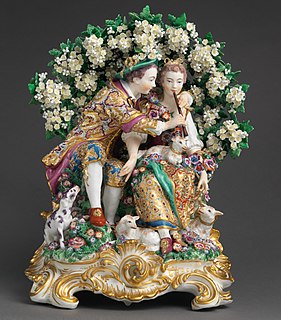
Chelsea porcelain is the porcelain made by the Chelsea porcelain manufactory, the first important porcelain manufactory in England, established around 1743–45, and operating independently until 1770, when it was merged with Derby porcelain. It made soft-paste porcelain throughout its history, though there were several changes in the "body" material and glaze used. Its wares were aimed at a luxury market, and its site in Chelsea, London, was close to the fashionable Ranelagh Gardens pleasure ground, opened in 1742.

In pottery hausmaler is a term for the artist, the style, and the pieces in hausmalerei, the process of buying pieces of pottery as plain "blanks", and then painting them in small workshops, or the homes of painters, before a final firing. In European pottery of the 17th to 19th centuries this was at certain times and places a significant part of production, and the decoration could be of very high quality. In England this was referred to as "outside decoration" and was also very important in the 18th and early 19th century, with some revival in the 20th.

The Royal Crown Derby Porcelain Company is the oldest or second oldest remaining English porcelain manufacturer, based in Derby, England. The company, particularly known for its high-quality bone china, having produced tableware and ornamental items since approximately 1750. It was known as 'Derby Porcelain' until 1773, when it became 'Crown Derby', the 'Royal' being added in 1890. The factory closed down in the past under Royal Doulton ownership, but production was revived under the renewed ownership of Hugh Gibson and Pearson family.

Royal Worcester was established in 1751 and is believed to be the oldest or second oldest remaining English porcelain brand still in existence today. Part of the Portmeirion Group since 2009, Royal Worcester remains in the luxury tableware and giftware market, although production in Worcester itself has ended.

The Museum of Royal Worcester is a ceramics museum located in the Royal Worcester porcelain factory's former site in Worcester, England.

Bristol porcelain covers porcelain made in Bristol, England by several companies in the 18th and 19th centuries. The plain term "Bristol porcelain" is most likely to refer to the factory moved from Plymouth in 1770, the second Bristol factory. The product of the earliest factory is usually called Lund's Bristol ware and was made from about 1750 until 1752, when the operation was merged with Worcester porcelain; this was soft-paste porcelain.

The Nantgarw China Works was a porcelain factory, later making other types of pottery, located in Nantgarw on the eastern bank of the Glamorganshire Canal, 8 miles (13 km) north of Cardiff in the River Taff valley, Glamorganshire, Wales. The factory made porcelain of very high quality, especially in the years from 1813–1814 and 1817–1820. Porcelain produced by Nantgarw was extremely white and translucent, and was given overglaze decoration of high quality, mostly in London or elsewhere rather than at the factory. The wares were expensive, and mostly distributed through the London dealers. Plates were much the most common shapes made, and the decoration was typically of garlands of flowers in a profusion of colours, the speciality of the founder, William Billingsley. With Swansea porcelain, Nantgarw was one of the last factories to make soft-paste porcelain, when English factories had switched to bone china, and continental and Asian ones continued to make hard-paste porcelain.

William Billingsley (1758–1828) was an influential painter of porcelain in several English porcelain factories, who also developed his own recipe for soft-paste porcelain, which produced beautiful results but a very high rate of failure in firing. He is a leading name associated with the English Romantic style of paintings of groups of flowers on porcelain that is sometimes called "naturalistic" by older sources, although that may not seem its main characteristic today.

The Royal Society of Painter-Printmakers (RE), known until 1991 as the Royal Society of Painter-Etchers and Engravers, is a leading art institution based in London, England. The Royal Society of Painter-Etchers, as it was originally styled, was a society of etchers established in London in 1880 and given a Royal Charter in 1888. Engraving was included within the scope of the Society from 1897, wood-engraving from 1920, coloured original prints from 1957, lithography from 1987 and all forms of creative forward-thinking original printmaking from 1990.

Henry George Sandon, MBE is an English antique expert, television personality, author and lecturer specialising in ceramics and is a notable authority on Royal Worcester porcelain. He was curator of the Dyson Perrins Museum for many years.

James Hadley was an English potter and artist associated with the Worcester Royal Porcelain Company. Until 1895 his work was produced almost exclusively by Royal Worcester; he later set up his own factory.

David Bates was an English landscape artist who painted in oils and watercolour.
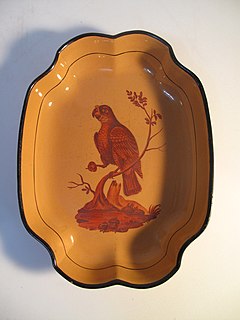
Davenport Pottery was an English earthenware and porcelain manufacturer based in Longport, Staffordshire. It was in business, owned and run by the Davenport family, between 1794 and 1887, making mostly tablewares in the main types of Staffordshire pottery.
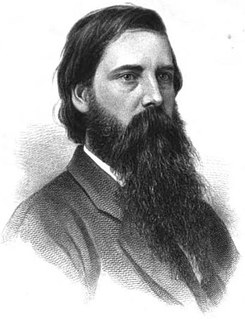
Lee & Shepard (1862-1905) was a publishing and bookselling firm in Boston, Massachusetts, in the 19th century, established by William Lee (1826–1906) and Charles Augustus Billings Shepard (1829–1889) Authors published by the firm included: George Melville Baker; Sophie May; Henry Morgan; Oliver Optic; William Carey Richards; Francis Henry Underwood; Madeline Leslie and Levina Buoncuore Urbino. The business conducted its operations from offices at 149 Washington St. (ca.1872); the corner of Franklin and Hawley St. (1873–1885); and "adjoining the Old South," no.10 Milk St. (ca.1885).
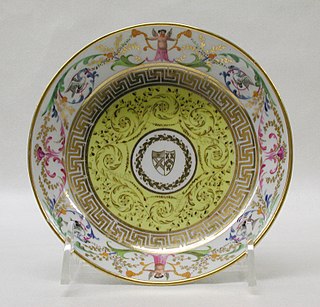
Thomas Baxter Jnr. was an English porcelain painter, and a watercolour painter and illustrator.
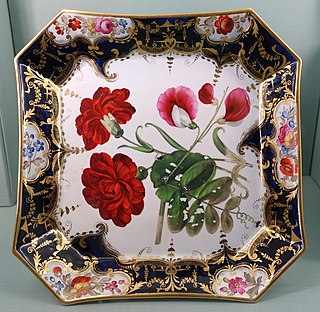
Coalport, Shropshire, England was a centre of porcelain and pottery production between about 1795 and 1926, with the Coalport porcelain brand continuing to be used up to the present. The opening in 1792 of the Coalport Canal, which joins the River Severn at Coalport, had increased the attractiveness of the site, and from 1800 until a merger in 1814 there were two factories operating, one on each side of the canal, making rather similar wares which are now often difficult to tell apart.
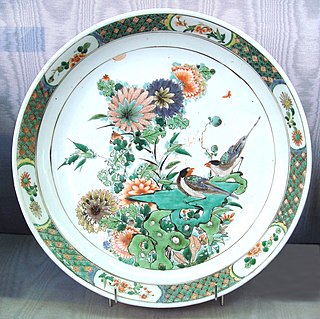
China painting, or porcelain painting, is the decoration of glazed porcelain objects such as plates, bowls, vases or statues. The body of the object may be hard-paste porcelain, developed in China in the 7th or 8th century, or soft-paste porcelain, developed in 18th-century Europe. The broader term ceramic painting includes painted decoration on lead-glazed earthenware such as creamware or tin-glazed pottery such as maiolica or faience.

Sir John Charles Robinson was an English painter and etcher, although he is now better remembered as an art collector and curator.



















